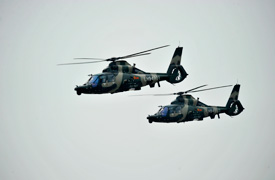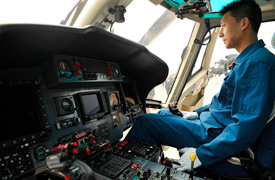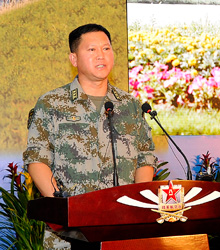|
 |
 |
|
FLIGHT PERFORMANCE: Two Z-9WZ helicopters of the Army Aviation Fourth Helicopter Regiment of the Chinese People's Liberation Army take flight in an aerobatic performance on July 24 at its base in Beijing (SHI GANG) |
LOOK INSIDE: The inside of a Z-9WZ helicopter (SHI GANG) |
Training matters
On July 24, one week before the 85th anniversary of the founding of the PLA on August 1, 160 reporters from 86 media outlets from China and abroad were invited to visit the regiment. It was the first time for an army aviation regiment to hold a media day after government and military departments have organized tours since 2008 for the media to have a closer look at the PLA.
The helicopter that Li and his teammates piloted during a flight performance that day was the Z-9WZ, a medium-sized military helicopter designed and manufactured by China and the first kind of armed reconnaissance helicopter fielded by the PLA. It can be armed with machine guns, cannons, rockets and missiles to attack air and ground targets or to provide fire support for ground troops.
Li said that he enjoyed singing, playing basketball and reading in his spare time as much as in college. The biggest difference between college and regiment life is the curriculum.
"The college curriculum ensures we become qualified pilots, while the regiment requires us to be capable combatants," Li noted. The regiment's flight training is considerably more intense, particularly those subjects concerning helicopter performance.
 |
|
MEET THE PRESS: Colonel Zhang Zhilin, Commander of the Army Aviation Fourth Helicopter Regiment of the Chinese People's Liberation Army, gives an informative briefing to media outlets from China and abroad (SHI GANG) |
Colonel Zhang Zhilin, 47, commander of the regiment, said the training is based on the Army Aviation Flight Training Program and the annual training plan issued by the Army Aviation Department. In recent years, the regiment has expanded its priority from basic training of new pilots to one that includes training commanders, instructors and chief pilots.
For example, training regiment leadership is focused on tactical command and the use of information-efficient equipment such as the integrated data link system. The training for commanders, instructors and chief pilots mainly features live fire aircraft exercises, night vision goggles training, transport helicopters' cross-region maneuvering, parachuting, pilot transition and simulator training.
It usually takes three to five years to train a college pilot after entering the regiment. The pilot's flight skills will be improved gradually through around 100 hours of flight training and massive annual combat training missions, according to Zhao Derong, deputy commander of the regiment and Li's pilot.
"The greatest progress is that we moved from real equipment in the past to today's massive simulator training, which is less costly," Zhang told Beijing Review.
| 